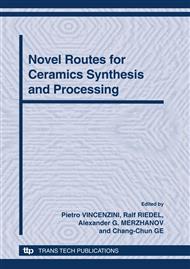p.358
p.364
p.370
p.374
p.383
p.392
p.396
p.402
p.408
Development of Functionally Graded Coating Based Plasma Facing Materials for Fusion Reactor
Abstract:
Different coating technologies, such as plasma spray (PS), physical vapor deposition (PVD) and chemical vapor deposition (CVD), which can fabricate the PFM and join it to heat sink materials simultaneously, were applied for the fabrication of plasma facing materials (PFM) in fusion reactor. In the Institute of Nuclear Materials, University of Science and Technology Beijing (USTB), the concept of functionally graded materials (FGM) was adopted to fabricate coatings for effectively alleviating the thermal stress generated between coatings and the substrate materials under high heat flux loading (5~20 MW/m2). In the last several years, functionally graded coatings, including B4C/Cu, W/Cu and Mo/Cu systems were successfully fabricated by atmospheric plasma spray (APS). Characterization of coatings was performed in order to assess microstructure, mechanical properties and high heat flux properties of the FGM coatings. Furthermore, a high thick tungsten coating with 4 mm on copper – chromium - zirconium (Cu, Cr, Zr) alloy substrates was fabricated by APS. The porosity of the coating is less than 2% while mean tensile strength of the coating is about 7 MPa. However, the content of oxygen in the coating is about 6 wt% by energy dispersive spectrum (EDS) analysis, thus further optimization is necessary.
Info:
Periodical:
Pages:
383-391
Citation:
Online since:
October 2010
Authors:
Price:
Сopyright:
© 2010 Trans Tech Publications Ltd. All Rights Reserved
Share:
Citation:


